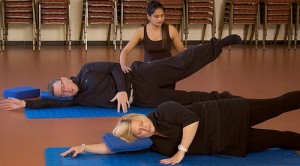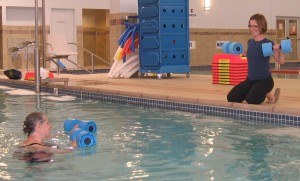by Michelle Sutton-Kerchner
The reasons to exercise and eat well are bountiful. Although many follow special diets to lose weight, for some it’s a matter of life or death. Such is the case for those enduring celiac disease …
What’s Celiac Disease?
Celiac disease (CD) is a lifelong autoimmune condition that is affected by the consumption of gluten. Gluten– typically found in wheat, barley, and rye– triggers an immune response in the small intestine in those with CD. Eventually, the small intestine’s lining becomes damaged and causes malabsorption (the body’s inability to absorb nutrients). It is not a food allergy or sensitivity. It cannot be outgrown.
The most common symptoms are gastrointestinal in nature, including stomach pain, diarrhea, and weight loss. Left untreated, other disorders from resulting nutritional deficiencies can occur, such as osteoporosis, anemia, and dental issues. Vitamin deficiencies deprive the brain, peripheral nervous system, bones, liver, and other organs of vital nourishment. Ignored, CD can be life-threatening.
Diagnosis and Diet
Although there isn’t a cure for CD, its symptoms can be managed through a healthy lifestyle. Once a physician makes a positive diagnosis, a gluten-free diet should be started immediately. Even if symptoms aren’t present, gluten consumption can still cause damage. Trace amounts can be harmful to someone with CD. Hence, it’s essential to obtain an accurate diagnosis and follow restrictions as necessary.
Healthcare practitioners often recommend consulting a dietician. S/he can assist in planning a balanced gluten-free diet. You can also obtain customized food plans that consider necessary vitamin increases based on your blood test results. The Center’s certified nutritionists are available to help you tweak your current menu or start fresh. Many foods may seem harmless, yet contain gluten derivatives. The unsuspecting bowl of soup or piece of candy could be a culprit.
Those who begin a gluten-free diet usually experience relief from symptoms over a period of several weeks. Occasionally, improvement can be felt in only a few days. Healing of the small intestine may take two to three years.
Exercise with CD? You Can & Should!

Exercise is an essential component of a balanced lifestyle. Balance is required to maintain the physical well-being needed to heal. We are all in the process of healing. Each time we sleep, the body is repairing and growing. Those with CD need to take special care to heal, some perhaps from a lifetime of foods that have been unhelpful to their being.
Maintaining a regular exercise program activates the “halo effect.” The positive qualities of physical activity easily carry to other aspects of life. Instead of being life’s spectator, you’re in the game. The game may be a simple walk around the pool’s perimeter but you’re in achievement mode. Making smart choices in one area can be infectious. Choosing to walk instead of drive may lead to choosing fruit for a snack instead of a less healthy temptation.
This sends a positive message to the brain: I am powerful and strong. It counteracts identifying oneself as sickly or ill. Movement helps management. It’s the catalyst for change.
Fitness can combat secondary issues that result from CD. Weight fluctuations are common. Prior to diagnosis, one may have lost an unhealthy amount of weight and need to rebuild him/herself. After diagnosis, a gluten-free diet may cause an increase in weight. The body will be capable of efficiently absorbing nutrients and maintaining calories. Some gluten-free foods may contain more calories than gluten equivalents, such as substitute breads and desserts.
In particular, weight training helps achieve a healthy muscle-to-fat ratio. It also helps strengthen bones, which may have been weakened by CD’s effect on calcium levels. Osteoporosis and osteopenia (lower than normal bone density) are frequent secondary outcomes of CD. Weight-bearing exercises can help prevent further weakening of bones and joints. Speak with a personal trainer or Group Fitness instructor to discover the most effective exercise programs and classes to improve bone health.
Exercise certainly perks up a sour mood, whether caused by ongoing stomach bloat or frustration from life with a chronic condition. You may not truly know deprivation until you’ve had to refuse delectable offerings in an effort to avoid a host of symptoms. Unlike most dieters, the person with CD knows eating gluten isn’t an indulgence for which can be later compensated. A splurge can have long-term consequences.

Commitment to an exercise routine may provide the emotional and physical energy needed to overcome feelings of self-deprivation. When the body is suffering, the mind can easily sink. Life feels fuller when in action, even though you may have foregone the random donut or serving of pasta.
Exercise also improves circulation. Better blood flow aids the digestive tract under any circumstance. It also accelerates healing. Although blood flow during a vigorous exercise routine is mainly directed toward muscles, overall circulation and digestive activity improves with regular exercise.
How to Exercise
When in the grip of CD, fitness often eludes one. A flare-up from a mismanaged diet or misdiagnosis can produce an overall malaise, including symptoms like general pallor, skin rash, exhaustion, and upset stomach. Motivation would be difficult to muster for any activity. The person with CD needs to approach exercise gently, with caution and encouragement.
Before nutritional deficiencies are replenished, the person with CD should consider current needs. Side-effects from vitamin deficiencies may correlate to the type and amount of exercise a person can withstand. Low iron levels could mean low energy. This could translate into a short, low-impact workout. A calcium deficiency could mean weakened bones. Consider pumping out reps on the Exercise Floor. A personal trainer can work with your dietician to create an overall wellness plan that strengthens you inside and out.
Regularly include protein in your diet, especially when exercising with CD. Foods high in protein and calcium help burn fat and build muscle. Building the body through a diet high in protein is necessary for the exerciser whose immune system may be weakened by years of malnutrition and misdiagnosis. Be careful not to endanger your muscles or skeletal system. Injuries and broken bones may occur more easily so listen closely to your body’s warnings.

Monitor your bone health. The impact CD has on bone health can be severely detrimental. Avoid high-impact fitness routines that wear on the bones. But don’t get discouraged. Pounding the pavement with regular run sessions may not be for you. Take another approach to that runner’s high. Investigate the exercise equipment or a new Group Fitness class that gives similar results without stressing your bones. A workout should not exacerbate soreness. Go gentle. Try Pilates, praised for its healing effects. Discover invigorating water workouts.
More on Gluten
The recent surge of health conscious individuals going gluten-free in their diets make those suffering from CD more mainstream in their nutritional requirements. Until recently, the term “gluten” was unfamiliar. Now, “gluten free” can be found on restaurant menus and in grocery store aisles.
 Some experts indicate gluten as a contributing factor in children with attention difficulties. In those with a gluten intolerance, gluten may be misinterpreted by the body and processed as a painkiller. This triggers symptoms of mental fogginess, sleep disturbances, and appetite changes.
Some experts indicate gluten as a contributing factor in children with attention difficulties. In those with a gluten intolerance, gluten may be misinterpreted by the body and processed as a painkiller. This triggers symptoms of mental fogginess, sleep disturbances, and appetite changes.
Food powers our cells, effects our thoughts, and enables (or disables) the ability to function. If you aren’t feeling your best, take time to track your diet. From minor discomforts to major disorders, foods– or mere ingredients– can be contaminating.
Seek Treatment
Don’t ignore signs or symptoms of CD. One long-term study showed individuals who were unaware they had CD were nearly four times more likely than people without CD to have died during the study’s 45-year follow-up.
Your physician can prescribe diagnostic testing to determine if CD is the cause. Avoid beginning a gluten-free diet prior to your physician’s approval. This can complicate a firm diagnosis. Those predisposed through genetics are at a higher risk for the disease and should be monitored.
An accurate diagnosis is critical to avoid confusion with other gastrointestinal disorders that mimic CD. Gluten can also cause another condition similar to CD called dermatitis herpetiformis, an itchy blistering skin disease. It, too, may damage the small intestine; however, it may not produce digestive symptoms. It is treated with a combination of gluten-free diet and medication for the rash.
Although celiac disease does not have a cure, it does not have to destroy. Become aware and make others do the same.
Sources
“Celiac Disease and Exercise,” by Robin Westen at www.thirdage.com.
“Exercise and Celiac Disease? Why Yes! Top 5 Reasons Why We Should Exercise Gluten Free,” at www.glutenfreefitness.com.
“How to Exercise with Celiac Disease,” by Bailey Vincent Clark at www.ehow.com.
“What Out for Gluten,” Rachel Rabkin Peachman, Parent & Child, June/July 2012.
www.celiac.com
www.celiac.org
www.mayoclinic.com
Image Credits
Woman stretching: http://www.flickr.com/photos/lululemonathletica/4883554451/
Pilates, guiding man (side): http://www.flickr.com/photos/sazztastical/4137020438/in/photostream/
Gluten-free cheesecake: http://www.flickr.com/photos/mpdrouin/6727265385/
Gluten-free sign: http://www.flickr.com/photos/whatshername/540926535/
 Fitness & Wellness News Your Source for Fitness News, Wellness News, Health News, and Nutrition News!
Fitness & Wellness News Your Source for Fitness News, Wellness News, Health News, and Nutrition News!



